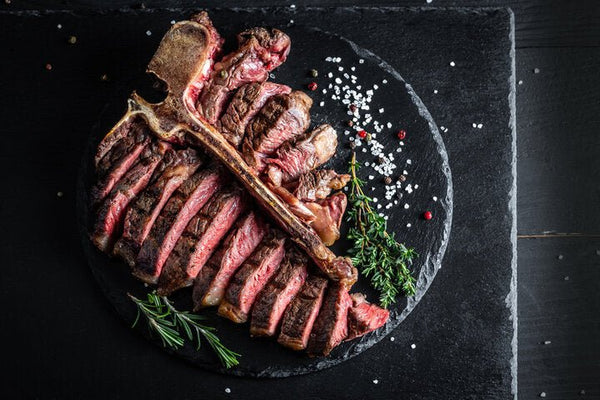A Guide to Bone-In Beef Cuts from Wellborn 2R Ranch
Discover the Rich Tradition of Bone-In Beef Cuts
Here in the heart of Texas, we take our beef seriously. It's not just food; it's a part of our heritage, a testament to the spirit of the land we call home. At Wellborn 2R Ranch, we're proud to introduce you to the robust world of bone-in beef cuts.
Understanding Steak Cuts
Bone-In vs. Boneless Cuts: A Primer
The main difference between bone-in and boneless cuts lies in the presence of the bone during the cooking process. While boneless cuts are often praised for their convenience and uniform cooking, bone-in cuts are celebrated for their flavor and juiciness. Understanding these distinctions is crucial for both chefs and home cooks aiming to make informed decisions about their beef selections.
The Butcher’s Perspective: Benefits of Bone-In Cuts
Enhanced Flavor and Juiciness
From the butcher's perspective, bone-in cuts are superior due to the enhanced flavor and juiciness they provide. The bone contributes to the meat's moisture retention, resulting in a more succulent steak. Furthermore, the fat and connective tissues adjacent to the bone add depth and richness to the flavor profile.
Selecting the Best Bone-In Cuts
Butchers play a crucial role in selecting the finest bone-in cuts. They look for well-marbled meat, optimal bone structure, and the right balance of meat to bone. These criteria ensure that the steak not only cooks evenly but also maximizes flavor.
The Chef’s Take: Cooking with Bone-In Beef
The Impact of Bone-In Cuts on Cooking Methods
Chefs worldwide agree that bone-in cuts require special consideration in the kitchen to bring out their full potential. The presence of the bone affects how heat is distributed throughout the meat during cooking. As a result, bone-in steaks often require a slightly longer cooking time than their boneless counterparts, but the reward is a steak with incomparable flavor and juiciness.
Mastering the Grill with Bone-In Steaks
Grilling is an art form, especially when it comes to bone-in cuts. Renowned chefs advise allowing the steak to reach room temperature before grilling and to use high, direct heat initially, followed by a lower, indirect heat to finish cooking. This method ensures a beautifully charred exterior while keeping the interior tender and flavorful.
The Science Behind the Flavor
Bones and Heat: A Flavorful Alliance
The bone in a steak plays a critical role in how the meat cooks. Bones conduct heat differently than muscle, slowing the cooking process near the bone. This slower cooking allows the meat adjacent to the bone to remain juicier and more flavorful, a phenomenon that chefs and food scientists alike appreciate.
The Maillard Reaction:
The Maillard reaction, a chemical process occurring when proteins and sugars in meat are exposed to high heat, is responsible for the delicious crust that develops on a well-cooked steak. Bone-in cuts, with their varied textures and distribution of fat, provide a perfect canvas for this reaction, leading to a steak that is visually appealing and bursting with flavor.
Bone-In Cut Showcase: The T-Bone Steak
Understanding the T-Bone Steak
The T-bone steak is a hallmark of traditional steakhouse menus and a beloved favorite among beef enthusiasts. This iconic cut represents the best of both worlds, combining the rich flavor of the strip with the tender succulence of the filet, divided by a characteristic T-shaped bone. This unique composition allows steak lovers to enjoy two distinct textures and flavors in one cut. The T-bone, a symbol of culinary indulgence, is sourced from the short loin section of the cow, where the most prized cuts of beef are found.
Mastering the Art of Cooking the T-Bone
Preparing the T-bone steak requires attention to detail and an appreciation for the craft of cooking. The presence of two different types of meat on either side of the bone means that achieving the perfect doneness is a delicate balance. It is recommended to sear the T-bone on high heat to lock in its natural juices, then finish cooking at a lower temperature, allowing the heat to gently penetrate the thicker muscle sections. Resting the steak post-cooking is crucial to ensure the juices redistribute evenly, resulting in a flavorful and moist eating experience.
Bone-In Cut Showcase: The Ribeye
A Closer Look at the Bone-In Ribeye
The bone-in ribeye, often referred to as the "king of steaks," is prized for its rich marbling and deep flavor. This cut comes from the upper ribcage, an area known for its tender, flavorful meat. The presence of the bone adds to the steak's appeal, providing extra flavor and ensuring the meat cooks evenly.
Cooking the Perfect Bone-In Ribeye
Achieving the perfect bone-in ribeye requires patience and attention to detail. Season the steak generously with salt and pepper, and let it sit at room temperature for about 30 minutes before cooking. For the best results, sear the steak on a high-heat grill or skillet, then finish cooking at a lower temperature, allowing the fat to render and the flavors to intensify.
Bone-In Cut Showcase: The Strip Steak
Exploring the Versatility of the Bone-In Strip Steak
The strip steak, also known as the New York strip when bone-in, is a favorite among steak enthusiasts for its balance of tenderness and flavor. This cut originates from the short loin, a section of the cow known for producing high-quality meats. The strip steak stands out for its fine marbling and robust beef flavor, enhanced further when the bone is left intact.
Masterful Cooking Tips for the Ultimate Strip Steak
Cooking a bone-in strip steak to perfection requires a blend of technique and timing. Season the steak with salt and high-quality pepper before allowing it to rest at room temperature. When cooking, use a preheated grill or cast-iron skillet to achieve a crispy, caramelized exterior while maintaining a juicy, tender interior. Resting the steak after cooking is crucial for retaining its juices and ensuring optimal flavor.
Bone-In Cut Showcase: The Filet
The Elegance of the Bone-In Filet
The filet, particularly when presented with the bone, epitomizes the pinnacle of culinary refinement and elegance. This esteemed cut, often overlooked due to its more famous counterparts, offers a unique combination of tenderness and flavor that is subtly enhanced by the bone. Within the sphere of high-quality beef, the bone-in filet stands out for its delicate texture and sophisticated taste profile, making it a favored choice among connoisseurs of fine dining.
Crafting the Perfect Bone-In Filet Experience
The preparation of a bone-in filet requires a nuanced approach to preserve its distinguished qualities. Seasoning should be approached with a light hand to complement, not overpower, the natural flavors of the meat. Cooking the bone-in filet to perfection involves precise temperature control and timing to ensure the tender meat remains succulent and moist
Nutritional Benefits
Understanding the Health Aspects of Bone-In Cuts
Bone-in steak cuts offer more than just flavor; they also present a range of nutritional benefits. These cuts are rich in proteins, essential amino acids, and minerals such as iron and zinc, which are crucial for maintaining a healthy body. The bone marrow, in particular, is a source of nutrients like vitamin B12 and fat-soluble vitamins, contributing to the overall nutritional value of the meat.
Comparing Bone-In and Boneless: A Nutritional Perspective
When comparing bone-in to boneless cuts, it's important to consider the slight differences in nutritional content. While the presence of the bone may not significantly alter the nutrient profile, the cooking method and the meat's proximity to the bone can affect its fat content and thus its calorie count. Understanding these nuances can help consumers make informed choices based on their dietary needs and preferences.
Worldwide Traditions: Bone-In Cuts in Different Cuisines
Global Appreciation for Bone-In Beef
Across cultures, bone-in beef cuts are celebrated for their deep flavors and traditional significance. From the Argentinian asado to the Korean galbi, bone-in cuts form the centerpiece of many national dishes. These global traditions highlight the versatility and universal appeal of bone-in beef, inspiring culinary creativity.
Exploring Cultural Cooking Techniques
Each culture brings unique methods and traditions to cooking bone-in beef. For instance, the slow-roasting techniques used in Italian bistecca contrast sharply with the fast, high-heat grilling found in American barbecue. These diverse culinary approaches offer valuable insights for home cooks and chefs alike, encouraging exploration and experimentation with bone-in cuts.



